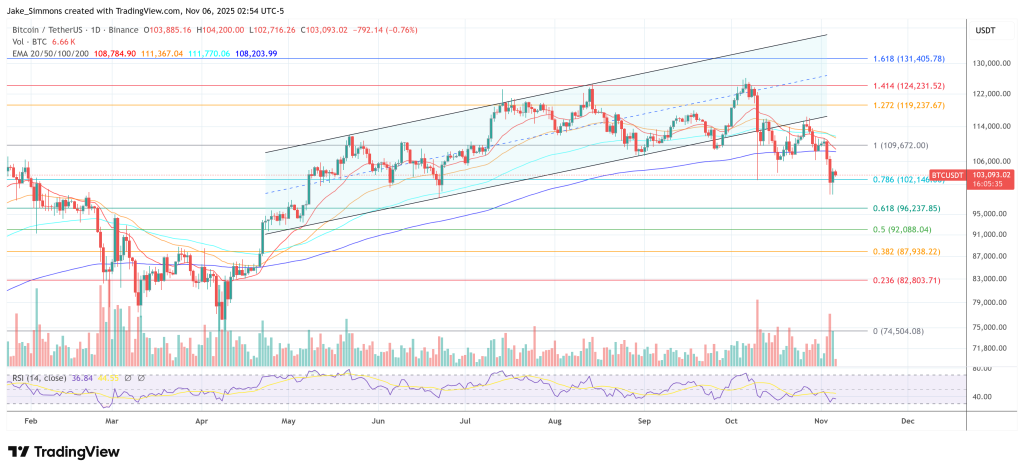Galaxy Digital has cut its 2025 year-end Bitcoin target to $120,000 from $185,000 in a new research alert circulated on November 5 and shared via screenshots on X by Alex Thorn, the firm’s head of firmwide research. In the note titled “Bitcoin Outlook Update: Lowering 2025 YE Target to $120,000,” Thorn situates the downgrade squarely in the context of a “major, multi-week selloff,” writing that “Bitcoin is trading below $100k for the first time since late June, with other cryptos faring worse.”
Thorn stresses that the shift is cyclical rather than existential, stating plainly: “While bitcoin’s structural investment case remains strong, cyclical dynamics have evolved.” The firm frames the current backdrop as a decisive turn in market microstructure: “Bitcoin has entered a new phase – what we call the ‘maturity era’ – in which institutional absorption, passive flows, and lower volatility dominate.”
That regime change helps explain both the tempered year-end target and the altered cadence of price discovery that Galaxy now expects. As Thorn puts it, “If bitcoin can maintain the ~$100k level, we believe the almost three-year bull market will remain structurally intact, though the pace of future gains may be slower.” Short-term optimism is not abandoned: “Still, we think nearing prior all-time highs before year-end is a reasonable target for short-term bulls.”
Reasons For The Bitcoin Downgrade
The downgrade aggregates several identifiable drags, beginning with distribution patterns across the holder base and the market’s capacity to absorb them. Galaxy writes: “Significant coin transfers from old holders to ETFs and new institutional buyers signal maturity, not weakness, but have presented headwinds.” This redistribution—whales handing supply to passive and institutional channels—may strengthen long-term ownership but has, in Galaxy’s telling, blunted near-term momentum.
Positioning and leverage are the second leg of the argument. Thorn flags the “significant leverage wipeout from Oct. 10” and adds that it “continues to dent market liquidity and confidence.” The October flush sits at the center of Galaxy’s cyclical reassessment: forced de-risking weakened order-book depth just as large-holder distribution accelerated, leaving price vulnerable into the latest drawdown.
A third component is the rotation of capital and narrative attention into other trades. Galaxy is explicit that “Bitcoin started the year as the hottest investment narrative, but AI, hyperscalers, gold, and the Magnificent 7 have absorbed capital and attention that might otherwise flow into BTC.”
That diversion extends into crypto-adjacent plumbing as well: “Rapid stablecoin growth has redirected venture and equity interest into fintech and payments infrastructure.” The net effect, according to the note, has been a drag on incremental demand for direct BTC exposure and a tougher funding environment for pure-play Bitcoin vehicles.
Retail participation, which defined prior peaks, is notably absent at sustained scale, and when it surfaces it tends to be flighty. Thorn writes: “Retail never fully returned at scale post-2021; when it did, the memecoin mania fostered short-termism that is not conducive to understanding and adopting bitcoin’s long-term value proposition.” Without sustained retail sponsorship, Galaxy expects ETF and institutional flows to “define BTCUSD behavior,” adding that “Passive Flows Dominate… lowering volatility and moderating cycles.” This, again, is part of the “maturity era” thesis rather than a repudiation of Bitcoin’s core investment case.
Policy timing features as a missing catalyst rather than a negative shock. The note observes that “Despite positive rhetoric, no government bitcoin purchases have been announced. In general, the US government has been very quiet on the Strategic Bitcoin Reserve (SBR).” Galaxy does not ascribe immediate downside to the absence, but it removes a bullish tail event that some investors had hoped would materialize this year.
Corporate treasuries and listed “Bitcoin-as-reserve” plays also receive a recalibration. Galaxy argues that the next iteration will demand business fundamentals rather than balance-sheet optics alone: “BTCTC Phase 2: The next wave of bitcoin treasury companies will mostly need revenue generation and operating businesses beyond reserve accumulation to differentiate themselves and thrive.” The firm also points to “poor performance of BTC treasury companies” as part of the year’s defining headwinds.
Taken together, the factors map to a post-$100k market defined less by reflexive retail surges and more by methodical institutional accumulation. Galaxy calls it the “Post-$100k Regime,” in which “Bitcoin’s ascendance above six figures earlier this year marked the transition from early-era speculation to mature, institutionalized markets.”
The conclusion threads the needle between structural conviction and cyclical prudence: “As a result of this market performance, and other factors, we are revising our 2025 year-end bullish bitcoin target from $185,000 to $120,000.”
At press time, BTC traded at $103,093.





